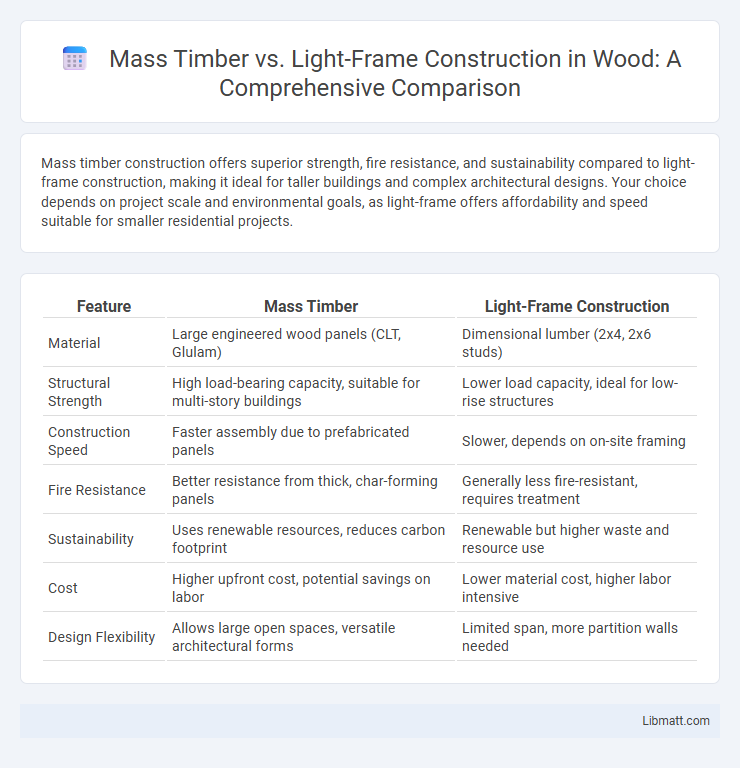Mass timber construction offers superior strength, fire resistance, and sustainability compared to light-frame construction, making it ideal for taller buildings and complex architectural designs. Your choice depends on project scale and environmental goals, as light-frame offers affordability and speed suitable for smaller residential projects.
Table of Comparison
| Feature | Mass Timber | Light-Frame Construction |
|---|---|---|
| Material | Large engineered wood panels (CLT, Glulam) | Dimensional lumber (2x4, 2x6 studs) |
| Structural Strength | High load-bearing capacity, suitable for multi-story buildings | Lower load capacity, ideal for low-rise structures |
| Construction Speed | Faster assembly due to prefabricated panels | Slower, depends on on-site framing |
| Fire Resistance | Better resistance from thick, char-forming panels | Generally less fire-resistant, requires treatment |
| Sustainability | Uses renewable resources, reduces carbon footprint | Renewable but higher waste and resource use |
| Cost | Higher upfront cost, potential savings on labor | Lower material cost, higher labor intensive |
| Design Flexibility | Allows large open spaces, versatile architectural forms | Limited span, more partition walls needed |
Introduction to Mass Timber and Light-Frame Construction
Mass timber construction uses engineered wood panels and beams, offering strength and sustainability benefits compared to traditional light-frame construction, which relies on smaller dimensional lumber like 2x4s and 2x6s for framing. Mass timber components, such as cross-laminated timber (CLT) and glulam, provide enhanced fire resistance, structural performance, and faster assembly times, making them ideal for mid-rise and tall buildings. Understanding the differences in materials and construction methods helps you choose the right approach for your building project's environmental impact and design requirements.
Key Material Differences
Mass timber involves large, solid wood panels or beams engineered for strength and stability, offering superior fire resistance and thermal performance compared to light-frame construction. Light-frame construction primarily uses smaller, dimensional lumber pieces such as studs and joists, which are easier to handle but less durable and require additional insulation. Understanding these key material differences can help you choose the most suitable option for your building's structural and environmental needs.
Structural Performance Comparison
Mass timber offers superior structural performance compared to light-frame construction, providing enhanced load-bearing capacity and greater resistance to seismic forces due to its engineered wood components such as CLT (Cross-Laminated Timber). Its inherent stiffness and dimensional stability reduce deflection and improve overall building resilience, making it ideal for mid-rise and tall wood buildings. Your project can benefit from the sustainability and strength of mass timber while achieving faster construction times without compromising structural integrity.
Environmental Impact and Sustainability
Mass timber construction offers significant environmental benefits over traditional light-frame methods by utilizing renewable wood materials that store carbon, reducing greenhouse gas emissions during the building process. Light-frame construction typically relies on steel and concrete, which are energy-intensive to produce and contribute more to carbon emissions. Maximizing the use of mass timber in Your projects supports sustainability goals through decreased embodied carbon and enhanced energy efficiency.
Cost and Economic Considerations
Mass timber offers competitive construction costs compared to traditional light-frame methods due to faster installation times and reduced labor expenses. Although initial material costs for mass timber can be higher, long-term economic benefits include lower maintenance and enhanced energy efficiency. Incentives for sustainable building practices further improve the financial viability of mass timber in commercial and residential projects.
Speed and Ease of Construction
Mass timber construction offers faster assembly times compared to traditional light-frame construction due to prefabricated panels and larger structural components, reducing on-site labor and minimizing weather-related delays. Light-frame construction typically requires more individual pieces and prolonged framing processes, increasing the overall build time. Your project timeline can benefit significantly from mass timber's streamlined installation, especially in complex or large-scale builds.
Fire Resistance and Safety
Mass timber exhibits superior fire resistance compared to light-frame construction due to its charring behavior, which creates a protective layer slowing combustion and maintaining structural integrity longer. Light-frame construction, typically composed of smaller dimension lumber, is more vulnerable to rapid fire spread and structural failure under high temperatures. Building codes increasingly recognize mass timber's fire safety advantages, incorporating stringent testing standards for mass timber assemblies to ensure occupant safety in fire scenarios.
Architectural Flexibility and Design Potential
Mass timber offers superior architectural flexibility compared to light-frame construction, enabling the creation of large open spaces and unique structural forms due to its strength and dimensional stability. Your design potential expands with mass timber's ability to support wider spans, curved shapes, and exposed wood aesthetics that enhance both functionality and visual appeal. Light-frame construction, while cost-effective for standard layouts, limits design complexity and open-plan possibilities because of its reliance on numerous small structural members.
Building Codes and Regulatory Aspects
Mass timber construction often requires specialized evaluation under building codes due to its novel fire resistance and structural properties, whereas light-frame construction benefits from well-established, prescriptive code guidelines. Your project's compliance depends on understanding code provisions like the International Building Code (IBC) chapters addressing combustible materials and fire safety for mass timber assemblies. Engaging with local authorities early ensures mass timber designs meet stringent regulatory aspects without compromising safety or approval timelines.
Future Trends in Timber Construction
Mass timber construction is gaining momentum due to its sustainability, enhanced fire resistance, and ability to support taller buildings compared to traditional light-frame methods. Innovations like cross-laminated timber (CLT) panels and modular assembly techniques are streamlining construction timelines and reducing carbon footprints. Future trends emphasize integrating smart technologies and hybrid designs that combine mass timber with other materials to optimize structural performance and energy efficiency.
Mass timber vs light-frame construction Infographic

 libmatt.com
libmatt.com